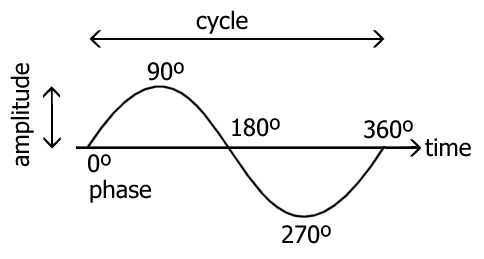
1. How can sound be described physically and perceptually?
2. What makes up the timbre of a sound?
3. What does the equal loudness curve represent?
4. What are the structures and functions of the outer, middle, and inner ears?
5. What are the receptors for audition, and how does transduction take place?
6. What are the pathways for audition?
7. How do place, frequency, traveling wave, and volley theories explain pitch perception?
8. What are the symptoms of and treatments for tinnitus? What are some effects of noise, and how can hearing loss be prevented?
- definition: ________ waves in the air produced by a vibrating object, which are detected by the auditory system
- distal stimulus: vibrating object
- proximal stimulus: pattern of _______ energy at the eardrum
Physical aspects of sound:

• _____: point along the wave, measured in degrees
(has no direct perceptual counterpart)
• _________: displacement of wave from peak to trough
- range of audible amplitudes is large:
threshold = 0.0002 dynes/cm2
maximum = 200 dynes/cm2
difference of _________×
- for large ranges, a ___________ scale is easier to work with:
p = sound pressure level (SPL) p0 = threshold SPL (20 μPa) |
Note: the formula in the textbook is
![]()
which is mathematically equivalent to
![]()
• _________: number of sound wave cycles per second
hertz (Hz) = |
# of cycles time (s) |
Perceptual aspects of sound:
• ________: perceptual experience of sound intensity (not “volume”)
- associated with amplitude & sound pressure
- to measure loudness, compare to a standard sound of 1000 Hz pure tone at 40 dB = 1 ____ of loudness
- to double loudness, increase dB by ~10 dB
e.g., 60 dB is twice as loud as 50 dB
• _____: quality of a sound ranging from low to high; allows sounds to be ordered on a musical scale
- most closely associated with frequency: ranges from 20 - 20000 Hz
- also affected by intensity:
▸ high frequency sounds seem ______ pitched as intensity increases
▸ low frequency sounds seem _____ pitched as intensity increases
- duration effects: sound < 10 ms long is heard as a “_____”
• relationships among frequencies:
- chromatic scale (e.g., “well-tempered” scale) of musical notes:
▸ one note is an ______ above another when its frequency is double that of the comparison
▸ octave subdivided into 12 intervals (or semitones), equally spaced logarithmically:
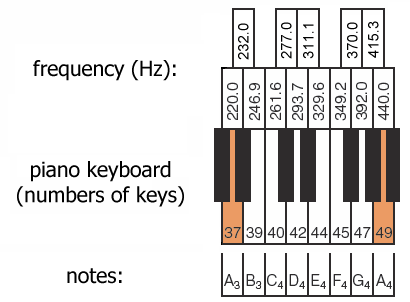
▸ tones in this scale match harmonic ratios found in the sound of human vocalization, specifically in English vowel sounds (Purves & colleagues, 2007)
- other scales use different ratios to establish a scale (a.k.a., “microtonal” or “microtuned”)
e.g., maqam quarter tone scale in classical Arabic music
• musical notes can be analyzed via Fourier analysis:
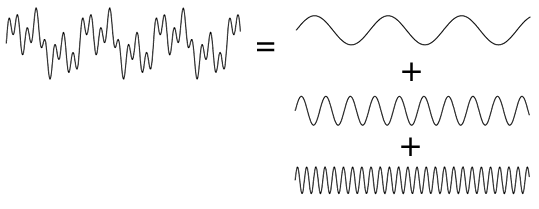
- ___________: lowest frequency in a Fourier spectrum of a complex sound wave
- _________: components of a complex sound having frequencies that are multiples of the fundamental
- the number and amplitude of harmonics contribute to the timbre of a sound
- these are represented in a Fourier spectrum, which graphs amplitude and frequency of each component:

• ______: “character” or “nature” of the sound
- makes a violin sound different from a piano
- due to the different frequency components (fundamental + harmonics) produced by vibrating source stimulus
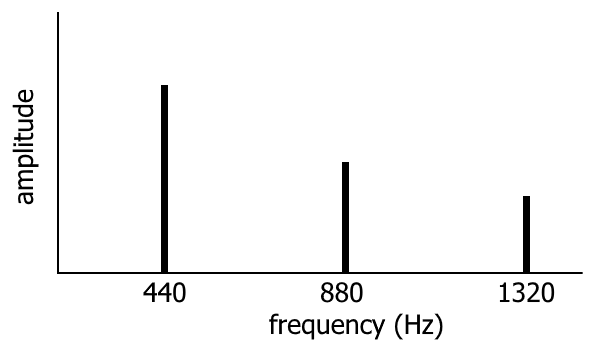
▸ sine wave:
▸ square wave:
▸ sawtooth wave:
▸ triangle wave:
▸ oboe:
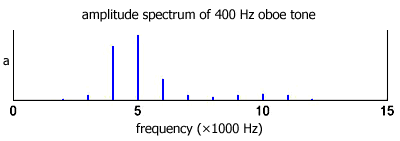 [oboe]
[oboe]
▸ clarinet:
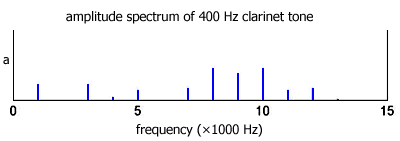 [clarinet]
[clarinet]
Sivian & White (1933):
- each frequency has a different threshold
- __________ curve: describes absolute threshold for hearing each different frequency
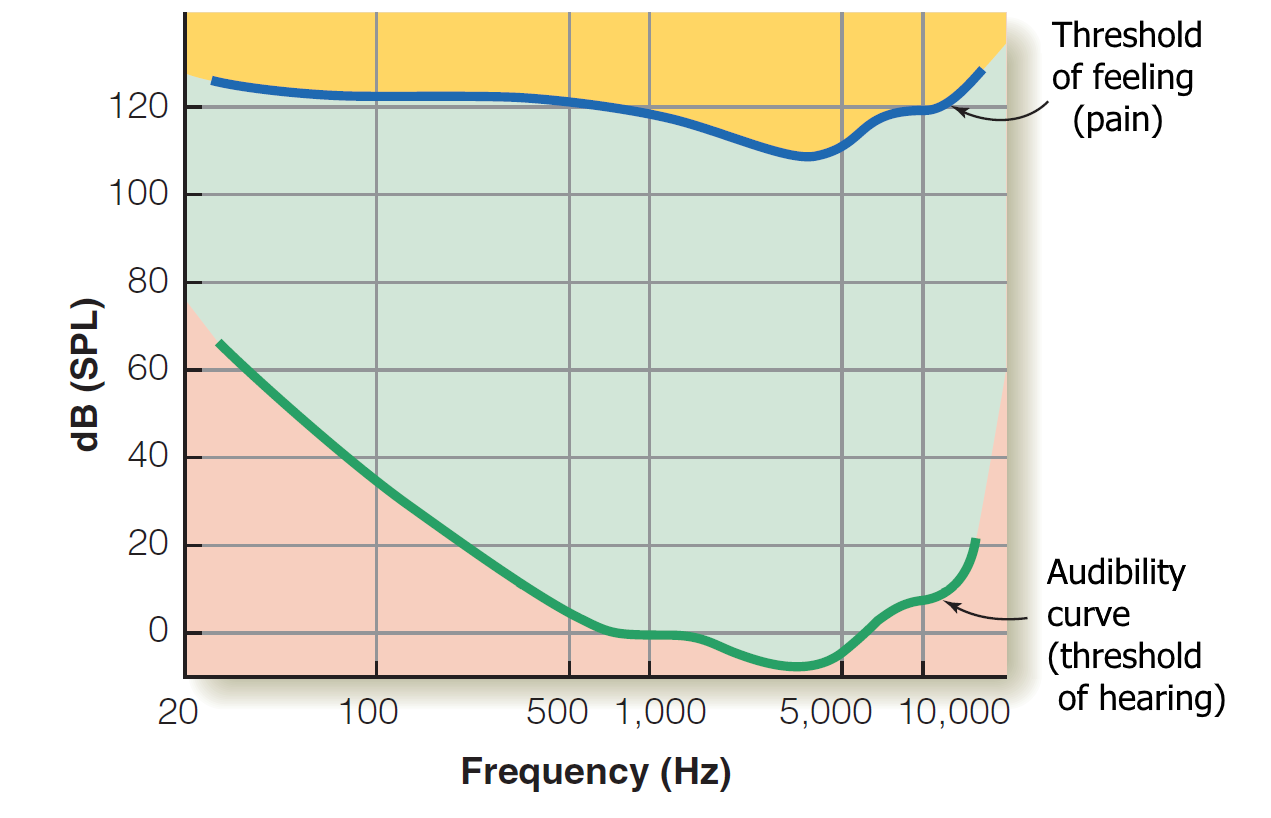
- auditory response area: the _______ range of intensities from threshold to pain
Fletcher & Munson (1933):
- _____ ________ curve: graph of decibel levels of various frequencies that seem equally loud
- how to determine:
1. present standard: 1000 Hz tone at a certain dB level
2. adjust intensity of other frequencies to match loudness of standard
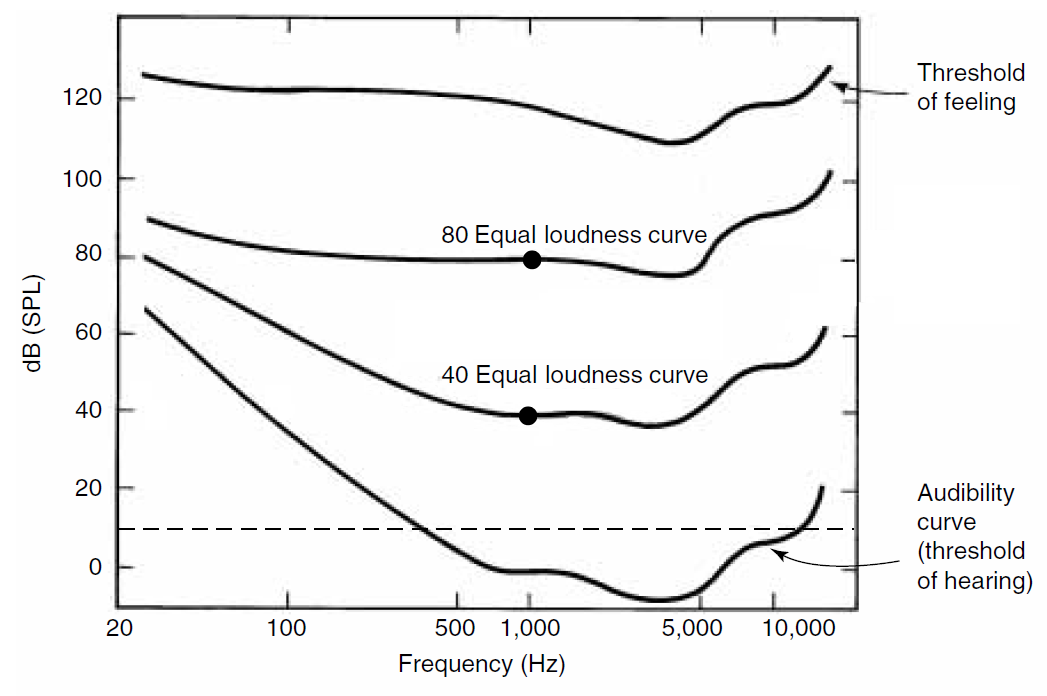
Also affected by:
• auditory __________: same sound seems softer if presented for a long time
• auditory _______: temporary hearing loss due to high-intensity sounds
- typically, frequencies at and above the sound are lost: range is 1.0-1.5× (half octave)
e.g., 1000 Hz exposure: 1000-1500 Hz affected
Outer Ear
• _____: the “ear” on the side of your head
- channels certain sound waves into:
• external auditory meatus (ear _____): ~3 cm long
- protects middle and inner ears
- amplifies frequencies 2000 to 5000 Hz via _________: sound waves near the resonant frequency of the ear canal are reflected from the closed end of the canal, reinforcing incoming sound waves of the same frequency (like blowing across the top of a bottle)
• tympanic membrane (_______): struck by sound waves and vibrates
- transmits sound to structures in middle ear
Middle Ear
• ________: malleus (hammer), incus (anvil), stapes (stirrup); supported by middle-ear muscles
- malleus connected to eardrum; stapes to oval window
- function of ossicles:
1) concentrate vibration of eardrum (0.6 cm2) to oval window (0.032 cm2); increases ________ by ~20:1 ratio
2) act as ______, increasing vibration by a factor of 1.3×
Why this need to increase pressure?
- outer and middle ear filled with air; inner ear with cochlear fluid
- transmitting wave into denser medium: loss of pressure
- ossicles help compensate for this loss
• __________ tube: equalizes middle ear pressure with outside
Inner Ear
• ____________ canals: involved in 3-D balance (vestibular sense)
• _______: snail-shaped structure, filled with cochlear fluid; has 2¾ turns; is divided into canals:
- scala vestibuli (vestibular canal)
- scala tympani (tympanic canal)
(connected by ___________ at apex end)
- scala media (cochlear partition): formed by basilar membrane and Reissner’s membrane; contains:
• Organ of Corti:
- tectorial membrane overhangs basilar membrane, which contains 15,000 hair cells
- inner and outer hair cells:
inner |
outer |
|
number: |
3,000 |
12,000 |
cell alignment: |
1 row |
3-5 rows |
cilia number: |
40-60/cell |
100-120/cell |
cilia alignment: |
straight lines |
V- or W-shaped rows |
function: |
_______ |
__________ |
• ______ ________ cells: 30,000 nerve fibres
- 95% are type I: 3-15 fibres/inner hair cell; large, myelinated
- 5% are type II: 1 fibre/10 outer hair cells; small, slow
• vibration → eardrum → ossicles → oval window → vestibular canal/cochlear partition (cochlear fluid) → basilar membrane
• basilar and tectorial membranes move laterally with respect to each other
• ________ force bends cilia of outer hair cells, which are embedded in tectorial membrane
• cilia of inner hair cells bent by fluid flow:
- _____ fibres link tips of cilia
- when the cilia bend, actin stretches and opens a “trap door”
- this allows K+ ions into the hair cell, which initiates the neural signal by releasing glutamate
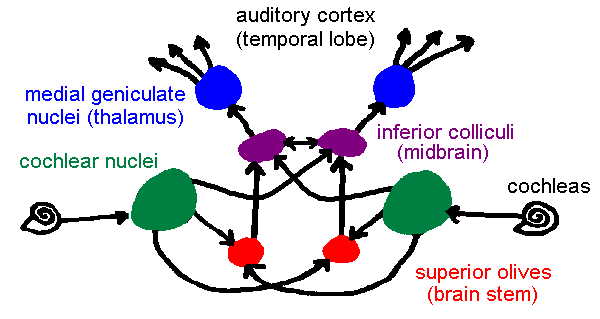
- axons of spiral ganglions comprise ________ nerve
- superior olives send efferent fibres (feedback) to the outer hair cells
• _________ organization: neurons activated by similar frequencies are found close to each other
- this organization is preserved from basilar membrane to auditory cortex
• 40% of neurons respond to noise, clicks, bangs
• 60% of neurons respond to a certain frequency
Why 60%?
- complex sounds can be decomposed by Fourier analysis into component sine waves (pure tones)
- this appears to be done by the auditory system
thus, we don’t need one neuron to respond to middle C on a violin, another for middle C on a piano, etc.
- but some neurons are responsive to specific stimuli: squirrel monkeys have squirrel-monkey-sound detectors
How does the auditory system encode pitch information?
Place Code: the activity of specific neurons encodes different frequencies

a) _________ Theory (Helmholtz, 1863)
- basilar membrane appeared to be composed of transverse fibres:

- sound makes fibre vibrate like a ____-string
- each fibre activated by a certain frequency
- problem: basilar membrane is all _________; no independent stringlike fibres
b) _________ Wave (Georg von Békésy, 1957; won Nobel Prize in 1961)
- traveling wave: entire membrane vibrates
- basilar membrane varies in elasticity down its length:
• narrow/stiff at oval window (base)
• wide/floppy at helicotrema (apex)
- each frequency has its own point of maximum displacement along the membrane:
• high frequencies activate hair cells at ____
• low frequencies activate hair cells at ____
Evidence:
• observation: seeing shape of traveling wave on basilar membrane; matched predictions
• many auditory neurons display frequency tuning curve: responsive to a narrow range of frequencies
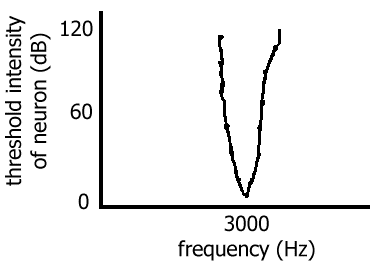
- point of greatest sensitivity: ______________ frequency
- partly due to selective connections from certain hair cells along the basilar membrane
• tonotopic organization:
- nerve fibres coming from base tuned to high frequencies
- those from apex tuned to low frequencies
• stimulation ________ experiments: high intensity sounds damage part of the organ of Corti:
- high frequencies: damage near oval window (base)
- low frequencies: damage near helicotrema (apex)
• ______ response:
- subsequent research showed pattern of vibration on basilar membrane is narrower than von Békésy found
- active process sharpens wave
- cochlear amplifier: outer hair cells sharpen wave around the peak by tilting and changing length
- two-tone ___________:
▸ present tone at characteristic frequency of a neuron
▸ turn on another tone, close in frequency to the other
▸ neuron’s response rate decreases
▸ due to outer hair cells affecting movement of basilar membrane
• masking experiments:
- one sound (masker) prevents us from hearing another (target)
- masking increases as masker and target frequencies become closer
- masking is ____________: target frequencies higher than masker are more affected than frequencies lower than masker
- due to location of vibration on the basilar membrane:
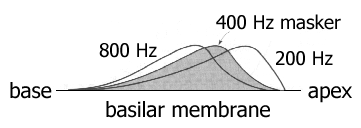
- to reduce file size, frequencies that would have been masked anyway are removed in the encoding of digital audio files (e.g., MP3 files)--a process called __________ coding
Problems:
• periodicity pitch: the case of the missing ___________:
What is the fundamental frequency in each case?



- problem for place coding: region on basilar membrane is not moving, so how is pitch corresponding to that location heard?
- present harmonics to one ear; other harmonics to other ear: missing fundamental will be _________
- this illusion must be determined by a CNS structure that integrates binaural information
- Getty & Howard (1981): central pitch processor analyzes the pattern of harmonics and selects the most likely fundamental frequency that would be part of the pattern
• although place coding works better for higher frequencies (the basilar membrane’s vibration is more narrowly tuned at frequencies over 5000 Hz), pitch perception seems to occur below 5000 Hz
e.g., notes on musical instruments do not exceed ~5000 Hz
e.g., melodies played solely using frequencies above 5000 Hz seem to lack a musical quality
Temporal Code: the timing of neural activity encodes different frequencies

a) _________ Theory (Rutherford, 1886):
- entire basilar membrane vibrates in synch with frequency:
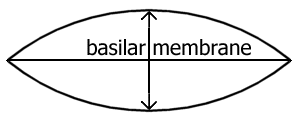
- assumed that each vibration produced one action potential in all receptors
- problem: actually, only part of membrane moves
- problem: refractory period of neurons--cells need time to recover before firing again; max frequency is 1,000/second
What about frequencies over 1000 Hz?
b) ______ Principle (Wever & Bray, 1937):
- groups of neurons fire alternately in volleys--some fire while others are refractory
- _____ _______: neuron firing is synchronized with the peak of a pure tone stimulus
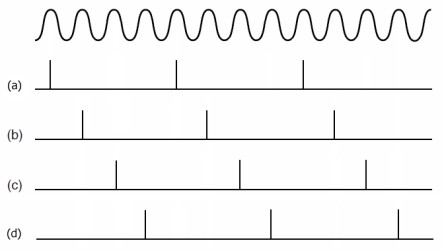
- frequency coded by which neurons are firing, and how much
- doesn’t work well at high frequencies; phase locking works best for low frequencies (below 5000 Hz)
Conclusion: there is evidence for both coding approaches; they work in combination (Plack, 2012).
- definition: hearing _______ in the ears, or experiencing a sound when none is present
- affects 13 million North Americans, including over 2.4 million Canadians (based on 2015 data)
- _____-worst thing that can happen to you (below only intractable severe pain, and intractable severe dizziness)
- can cause difficulty concentrating; anxiety, and depression
- most commonly caused by ____ sounds, but also certain drugs, ear infections, or ____ allergies
- early theories implicated emissions/acoustic echoes in the ear
- but recent research implies more central mechanisms:
• patients who had cancerous auditory _____ removed developed ringing
• fMRIs of patients with ringing in only one ear showed area in inferior colliculus affected
• some Deaf people can modulate intensity and pitch of the ringing by moving their ____ left or right
- current theories:
1. destroying hair cells causes the brain to _____ areas previously served by the destroyed hair cells, resulting in abnormal brain activity
2. due to decreased incoming stimulation, there is less __________ in the auditory cortex, resulting in more excitatory activity and phantom sound
- although there are dozens of treatments (including drugs, electrical stimulation, and surgery), there is no ____
- tinnitus masker may help: _____ noise generator that masks the ringing
World Health Organization (2011):
• Americans 3 or older with some form of auditory disorder has more than doubled since 1971, from 13.2 million to about 30 million in 2006
• 33% have _____-_______ hearing loss (NIHL)
• noise is “unwanted or harmful outdoor sound created by human activities, including noise from road, rail, airports and from industrial sites” (p.1)
• 2% of Europeans suffer severely disturbed sleep due to noise pollution
• chronic exposure to loud _______ noise causes 3% of all cases of tinnitus
• noise (even while asleep) leads to chronic ______, inflammation, and alterations in gene activity which cause heart attacks and strokes; worldwide death toll about 210,000
• reading ability of children in classrooms next to noisy railways in NYC was 3-4 months behind those in quieter classrooms
• children’s LTM recall improved by 25% after nearby airport was closed in Munich
Can hockey playoffs harm your hearing? (Hodgetts & Liu, 2006):
- attended Oilers’ 2006 Stanley cup final games at Rexall Place
- wore noise dosimeter
- average exposure levels were about 100 to 104 dB (in a workplace environment, hearing protection would be required by law)
- data from game 3 shows peaks above 120 dB:
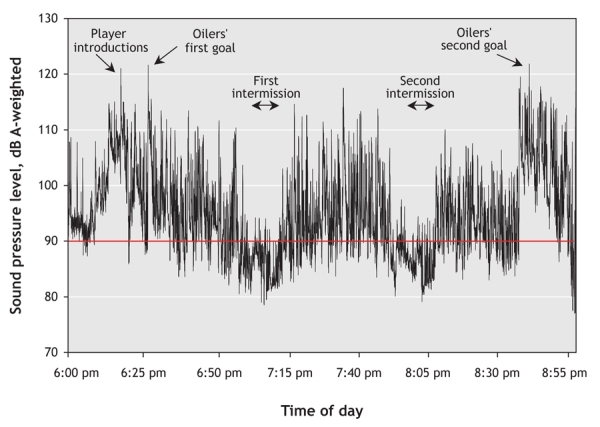
- audiometric tests showed hearing thresholds deteriorated by 5 to 20 dB
___________: age-related hearing loss, due to degeneration of hair cells and cilia
- more likely to occur with increasing age
- higher frequencies are more attenuated with age
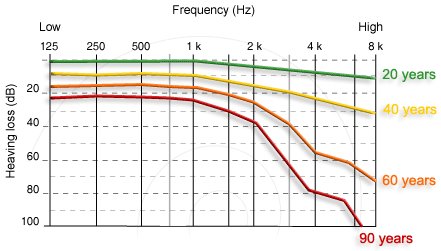
• The Mosquito™ anti-loitering device uses 85 dB tone at 17.4 kHz to repel youths
• “Teen Buzz” or “Mosquito” ringtones higher than 8 to 22 kHz cannot be detected by adults
- presbycusis causes include: heredity, vascular diseases, ototoxic drugs, and exposure to loud noise
- younger people are increasingly experiencing NIHL: 30% listen to levels of at least 91 dB for an average of 2.9 hours/day
Warning Signs of Noise Exposure/Hearing Loss:
• ringing/buzzing in the ears
• muffled sounds
• difficulty understanding ______
• difficulty following conversations over background noise
• having to turn up the __ to hear it clearly
How to Prevent Noise-Induced Hearing Loss:
• turn down/_____ high intensity sounds
- iPhone capable of up to 115 dB (EU regulations require default maximum to be 85 dB)
- most vulnerable occupations: musicians, __________/_______, mechanics, construction workers, dentists & assistants
• wear ________
- typical NRR (noise reduction rating) ~30 dB, cost about 25¢ (foam) to $1 (silicone)
- ______ _____ NRR ~3dB
- custom musician earplugs reduce “head noise” from _____ vibrations, cost about $200